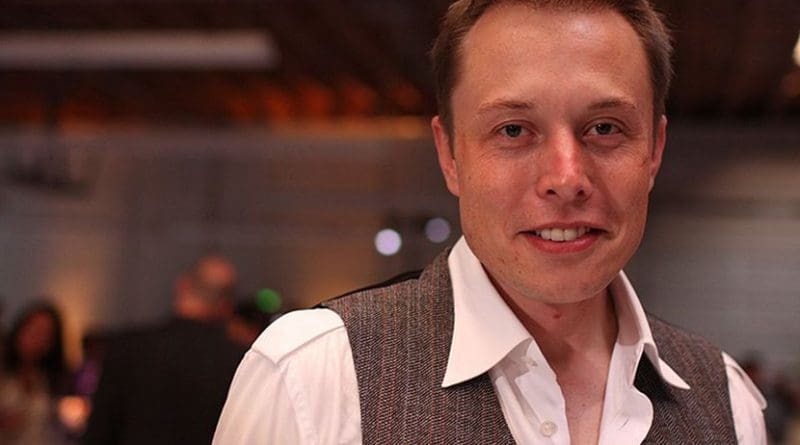Elon Musks’s Taxpayer-Funded Gravy Train – OpEd
By MISES
By Allan C. Brownfeld*
Elon Musk and his corporate empire, much of it financed by taxpayer dollars, is very much in the news. Most of it is not good. And it may be getting worse.
Tesla spends $1 million annually on Washington lobbyists. Its cars are financed by over $280 million in federal tax incentives, including a $7,500 federal tax break and millions more in state rebates and development fees. SpaceX has also received over $5 billion in government support. It has over promised and under delivered. SpaceX rockets, for example, are far less reliable than many of its competitors. This is outlined in reports from December 2017 and January 2018 in which the Department of Defense Inspector General and NASA’s Aerospace Safety Advisory Council described a list of security concerns they have with SpaceX, among them 33 significant non-conformities.
Bloomberg Business News reported in November about a Tesla solar factory for which the State of New York paid $750 million based on a commitment to create 1,500 jobs. The factory had been developed for another Musk-run company, SolarCity, which Tesla bought in 2016 in a $2.6 billion deal. SolarCity had been $2.9 billion in debt. Only a relative handful of jobs have been created, and New York officials are expressing dismay. Raymond Walter, a Republican in the New York State Assembly, says he is concerned that the state “has too many eggs in the Tesla basket, which doesn’t seem like a very strong basket.” John Kaehny, executive director of Reinvent Albany, a nonprofit focused on government accountability, says, “It’s a complete hoo-ha! These mega-subsidy deals take place in complete secrecy without scrutiny from the public.”
Bloomberg News declares that this is “…a familiar playbook for Musk, start with wild promises followed by product delays, production hell, shareholder anger and finally, hopefully, redemption.”
Things, however, may be even worse than they appear. Some are even speculating that Elon Musk, SpaceX and Tesla may be on their way to becoming the new Enron. Enron, the energy giant, employed approximately 20,000 people and claimed revenues of $111 billion at its peak by 2000. As it turned out, Enron used shady accounting practices to hide its losses and report profits which, in fact, did not exist. Andrew Fastow, the chief financial officer, created the scheme to falsify Enron’s real financial status. In April 2001, the fraud began to unravel as analysts began to question Enron’s numbers. In the end, Enron was found to have losses of $591 million and debt totaling $628 million. Stock prices declined from $90 in 2000 to less than one dollar when the scandal was exposed. Senior managers, who kept selling their stock while encouraging others to continue buying, were convicted of insider trading. In December 2001, the company declared bankruptcy.
In the view of many, Elon Musk has been engaging in similar behavior. A Bloomberg report in November suggests that SpaceX may be less than honest with its numbers, giving a false illusion of profitability. According to Bloomberg , “While SpaceX is burning through cash, disclosures to potential lenders showed the company had positive earnings before interest, taxes, depreciation and amortization of about $270 million for the 12 months through September, people with knowledge of the matter said. But that’s because it included amounts that customers had prepaid and because it excluded costs related to non-core research and development…Without those adjustments, earnings were negative, they said.”
According to Bloomberg , “This shouldn’t come as a shock. A Wall Street Journal report from a few years ago showed that its profit margins were laser-thin. But if Musk is now going to these lengths to pad SpaceX’s books to secure a loan, it appears there’s a serious problem.”
In the case of Tesla, the Wall Street Journal reports that, “Federal investigators are probing whether Tesla’s stated information about production of its Model 3 electric sedans had misled investors about the company’s business. Under examination is Tesla’s public statements about Model 3 productions as compared to the number of vehicles that were actually built.”
Elon Musk and his companies have a very questionable record when it comes to truth and honesty. Overstating prices to qualify for higher state tax credits seems to fit a pattern. According to a recent report in The Oregonian/Oregon Live, “The state of Oregon has recovered $13 million it paid to Tesla for solar power projects, after an investigation conclude the company inflated prices to qualify for higher tax credits.”
Whether Elon Musk, Tesla and SpaceX will go the way of Enron is impossible to know, but that they should not be the recipients of taxpayer dollars seems clear. And whatever the future holds, speculation has already begun.
Marketwatch reports:
“Is Tesla the next Enron? One hedge fund manager charts a gloomy path.
Harris Kupperman of Praetorian Capital recently compared Tesla to one of
the biggest falls Wall Street has ever seen.”
Time will tell,
but in the interim, the government should put its cozy relationship with
Musk on a long, if not permanent, hiatus.
*About the author: Allan C. Brownfeld, a former U.S. Senate staffer and consultant to the Vice President, is a freelance author, Contributing Editor of The St. Croix Review, Associate Editor of The Lincoln Review, and editor of Issues.
Source: This article was published by the MISES Institute

